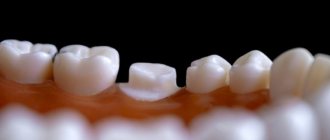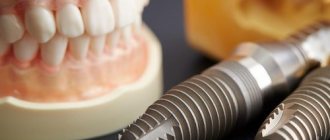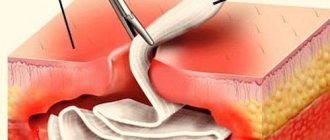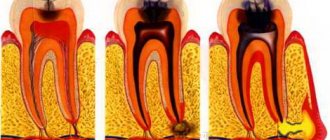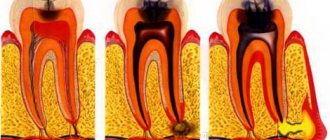What should you do if a small piece of your front, upper, lower or back tooth breaks off? Is it worth resorting to extraction (completely removing the crown) and then installing a prosthesis? Why do strong, hard tissues crack and make your smile unattractive and chewing food painful? In fact, the problem is quite common and can be eliminated in a short time if you consult a dentist in time and do not neglect treatment. In addition, there are preventive measures that, if followed, will help avoid the formation of cracks and chipping.
Reasons for chipping
What causes pieces of teeth to break off (what to do next depends on the provoking factors) most often:
- Traumatic effects on the dentition. This is possible due to a fight, a fall, or an accidental blow.
- Decreased immunity.
- Poor quality installation of orthodontic structures.
- Hormone imbalance. One of the prerequisites is diabetes mellitus and other endocrine diseases.
- Consumption of harmful foods. Caramel candies, nuts, and the simultaneous consumption of hot and cold foods lead to injury.
- Untreated dental pathologies.
- Incorrect positioning of incisors, canines and molars and nocturnal bruxism.
- Damage to caries. This applies to both the initial and later stages.
- Smoking and other bad habits. Alcohol and cigarettes contribute to the thinning of the enamel layer.
- Demineralization, lack of phosphorus, calcium and other essential substances.
- Low acidity in the mouth. An insufficiently balanced diet leads to an imbalance in the acid-base balance.
- Damage to the filling material.
- Presence of cracks on the surface.
- History of chronic diseases.
Causes of cracked teeth
The force of pressure on the teeth when chewing reaches 400 kg/cm². Healthy and strong crowns can easily cope with such a load. If the enamel is weakened or excessive pressure is applied, the tooth can crack. Factors contributing to the appearance of cracks in teeth:
- malocclusion, bruxism;
- depulpation (removal of a nerve);
- absence of one/several teeth (uneven load distribution);
- deep caries (destruction of 50% of the crown or more);
- injuries (fall, blow to the face, accident);
- genetically determined weakness of tooth enamel;
- poor nutrition leading to a lack of fluoride, calcium, phosphorus;
- excess sugar in the diet;
- temperature changes when eating (cold-hot);
- habit of biting pens and nails;
- teeth whitening at home;
- traumatic treatment of dental canals, excessive tightening of braces.
Important! Teeth with weakened enamel may crack when eating hard foods (such as crackers). However, chipped teeth more often occur due to prolonged exposure to adverse factors.
Symptoms
Treatment of a small chip on the enamel of a tooth (front or back) should be started as early as possible. If the broken fragment is too small, it may not cause any discomfort, only aesthetic. This does not mean that you should neglect a visit to the doctor, since very soon the problem will grow to much more serious proportions, and therapy will be long and expensive.
Characteristic symptoms:
- visible cracks on the surface;
- loss of filling;
- exposed nerve endings;
- violation of the integrity of the coronal part;
- increased sensitivity to temperature changes;
- pain syndrome, especially at night.
WHY ARE COMPLEX TEETH DONE IN PARTNER-MED?
We know how to work!
We have orthopedic dentists with 8-30 years of experience!
We love to work!
We will give you a free consultation and tell you exactly how best to make your teeth better!
We are responsible for the result!
We work conscientiously and will make your teeth LIKE YOURSELF!
Types of damage
There are several types of dental injuries with fractures. The classification sign is the depth and degree of injury.
Enamel chip or microcrack
In this case, the integrity of the upper layer of hard tissue is compromised - it cracks, or a small fragment separates. Usually such problems are invisible and do not cause discomfort. These are minor defects that can be quickly treated, but people do not rush to the dentist with them, which is a serious mistake.
What to do if part of a front tooth or a piece of a back tooth chips or falls out? It is important to visit a dental clinic as soon as possible. Damaged structures will become a place for the spread of pathogenic microflora, which will provoke the development of caries and other diseases. In addition, the load when chewing food will increase significantly, so half of the crown may fall off at any moment.
Chip with dentin fracture
Dentists classify this type of damage as moderate. Symptoms may be pronounced or completely absent. If the dentin layer is not restored, the unit will gradually crumble and soon fall apart. In addition, the smile will become unattractive, especially if a piece of an incisor is missing.
Deep fracture to the pulp tissue with exposure of the nerve
This is a severe injury with serious symptoms such as bleeding and severe pain. Even strong painkillers help dull unbearable sensations only for a short time. The crown may be missing half or more. If you are late with medical intervention, the risk of infection, inflammation and other pathological processes that are difficult to treat increases significantly.
Features of artistic restoration using composites
First of all, the patient is promptly restored to the shape of the tooth using “available” materials in order to maintain the aesthetics of the smile area during treatment. The level of today's dental materials is so high that some patients are completely satisfied with such restoration and refuse further cooperation. Therefore, for not the most motivated clients, temporary modeling is performed without achieving complete color similarity.
Then a silicone impression is taken from the damaged and temporarily restored tooth, on the basis of which a so-called key will be made, which will allow the artistic part of the work to be completed with high quality.
To achieve an ideal resemblance, the dentist, even with a small chip, has to combine from 3-4 to 5-6 shades of the photopolymer composite. If you do this at random, the patient will not be very pleased with the result: the restored part will differ from natural tissue. The key helps to accurately maintain the relationship between all layers of material of different tones, so that the saturation, lightness and transparency of the restored and natural parts completely coincide.
What to do if a piece of a tooth breaks off
First of all, you need to visit a dentist. Panic is unacceptable, since the situation is fixable, and at the initial stage it is quickly corrected. A specialist should examine the oral cavity and assess the extent of the problem. If the damage is mild or moderate, it is advisable to carry out treatment in the coming days. If the pulp is exposed, you need to urgently go to the doctor on duty. Otherwise, the patient will not be able to eat, rest, or sleep normally due to unbearable pain.
Relieving symptoms at home
To reduce discomfort and relieve pain, it is necessary to organize pre-medical care. The remaining manipulations will be performed by professional doctors after a visit to the dental clinic. Procedure:
- Rinse your mouth with clean running water.
- To reduce swelling, apply a cold compress to the inflamed area. Apply a sterile bandage if bleeding occurs.
- Take painkillers.
If a piece of a tooth breaks off, the nerve hurts, or the root is split, you should not throw away the fragment of tissue; it is better to show it to a doctor. The fragment may be needed for subsequent restoration.
Emergency assistance before visiting the dentist
Immediately after the incident, urgent measures must be taken. All the steps listed above are mandatory: first, splinters and particles of food are removed by rinsing, then cold is applied to the gums to eliminate inflammation and discomfort, and oral analgesics are used.
Additionally, it is recommended to rinse the mouth with a weak antiseptic solution. To do this, you can use chlorhexidine, furatsilin or any other gentle composition.
Treatment by a doctor
There are several ways to repair a chipped tooth (how it is treated depends on the degree of damage and the presence of pain). Therapeutic intervention options:
- Artistic restoration. Special composites are used. Acceptable when breaking off small fragments.
- Installation of veneers and lumineers. Used for cracks, chips and formation of crevices.
- Recover using tabs. This is how a significant piece of bone tissue is reproduced.
- Prosthetics (crowns). Indicated when most of the dental unit is missing.
conclusions
- Restoration is possible if the upper, lower, front or side teeth have broken off;
- For restoration, methods of mineralization, plugging with a composite, extension, prosthetics with a crown on a pin, or a stump inlay are used;
- if the root is preserved, the tooth can be restored, even if the coronal part is fractured at the base;
- a root fracture can be treated if the pulp is not damaged;
- in cases where the tooth cannot be saved, it is removed, followed by implantation or installation of a bridge;
- The implant performs all the functions of a natural tooth and prevents bone tissue atrophy;
- the extended tooth is no different from others and looks natural.
Expert of the article Bolshakova Evgenia Vladimirovna Dentist-hygienist
More than 11 years of experience
Restorative methods in dentistry
The method of restoration depends simultaneously on several factors: the degree of damage, the results of diagnostic studies, general health, medical history and financial capabilities of the patient. The therapeutic regimen is developed on an individual basis. What to do if a front tooth is chipped and why the back teeth are chipped should only be determined by a doctor; self-diagnosis is ineffective.
Remineralization
Remineralization therapy is the simplest recovery option for minor chips. The technique is used for microcracks and other small defects, as well as for preventive purposes to prevent such problems. A special solution with nutrients is applied to the surface, and as a result, the protective properties of the enamel are restored.
Fluoridation
Damaged and healthy teeth are covered with medicinal solutions, gels or varnishes with a large amount of fluoride. Treatment is carried out in stages. This is one of the effective ways to completely restore a chipped front tooth. This method is only beneficial for minor injuries.
Building up
Indicated for moderate injuries. A paste-like mass is applied to the surface in layers, each layer is fixed. The doctor must carefully select materials of the desired shade and texture so that the restored areas remain invisible and do not stand out from the rest.
This method is highly effective and attractively priced. The first thought that arises in most patients when asked what to do if a back tooth is chipped (chipped front teeth are rarely eliminated in this way) is to build up the missing fragment. The technique is in great demand.
Filling and microprosthetics
They are indicated for extensive damage to bone tissue and internal sensitive layers. The doctor carefully examines the results of diagnostic studies (including panoramic and spot images), listens to the patient’s complaints and advises which method is best to use. Restoration is possible using conventional fillings, inlays, veneers, and lumineers. What to do if a back tooth breaks off (the reasons do not matter) and is completely lost? In such a situation, prosthetics using implants or installation of artificial crowns is performed.
The amount that the patient sees in the final settlement after the intervention may be unpleasantly surprising. Before you ignore a small crack in the enamel and neglect a visit to the dentist, it is better to think about possible upcoming expenses.
What types of cracks are there?
Damage to the dental crown can have different localization and direction. The nature of the crack largely affects the ability to preserve the natural crown, and sometimes the tooth itself.
First of all, cracks are divided into two types: external and internal. Hidden injuries are considered more dangerous when damage to the root or pulp occurs. The chances of saving a tooth if the root has fractured are slim. In case of concomitant pathologies, for example, inflammation of the pulp, dentists preferentially resort to tooth extraction.
Depending on the direction, there are three types of injury.
- Diagonal. The crack runs from bottom to top in an oblique direction. If a tooth is cracked to the root, it can be saved, but only if there is no damage to the internal tissues. Even a complex crown fracture can be restored using composite materials.
- Horizontal. These injuries are the most common and predominantly occur as a result of trauma to the jaw. When a tooth is split in half horizontally, it can be saved. Depending on the area of the chip, a composite material or orthopedic pads attached to pins can be used.
- Vertical. The crack on the crown runs vertically. Visually, it gives the impression that the tooth is split into two parts. The longer the crack, the higher the likelihood of damage to internal tissues, including the jaw bones.
Dentists pay attention to eliminating damage to chewing teeth. Chewing function directly depends on the strength of the crown. A damaged tooth can no longer fully perform its function. A vertical crack in your teeth may require crowns on your molars or veneers on your front teeth.
Special cases
Some injuries require a specific approach, which has its own characteristics against the backdrop of generally established rules. We should look at them in more detail.
Wisdom tooth
"Eights" cannot be restored. The fact is that this makes no sense, because they are not involved in the process of chewing food and are not so important for the functioning of the maxillofacial apparatus. Doctors resort to extraction; subsequent prosthetics are not performed.
Unit
Such damage is the most aesthetically unattractive, because it is visible to others if a person smiles or simply talks. Treatment methods can be any, it all depends on the dentist’s recommendations and the patient’s personal preferences and financial capabilities.
Most often, artistic restoration is used. The specialist selects the composition of the required shade and applies it to the surface. The layer of material is fixed with a special device with light radiation.
What to do if half a tooth breaks off, how will it be treated (a significant fragment has broken off along with dentin)? In this case, veneers are used. This is a reliable method that is durable. Over time, the color of the enamel does not change and remains attractive.
For the most serious damage, crowns made of ceramics, metal-ceramics, and zirconium oxide are installed. The final cost of therapy depends on the choice.
Lateral teeth
They are treated in the same way as the front ones. However, since others cannot see from the outside that there is anything wrong with your smile, ordinary fillings will do. The best option is extension. Overlays are not installed in this case.
If the nerve is damaged, the wound is first treated with an antiseptic. Then depulpation or extraction is carried out followed by prosthetics.
Dairy elements
What to do with a chipped tooth and how to treat it if it hurts? Many parents mistakenly believe that there is no need to correct problems that arise with children’s first incisors, canines and molars - they will fall out sooner or later anyway. This is a big misconception, because the doctor is able to quickly stop further cracking with a filling or a special gel without pain or other unpleasant sensations.
Children are often injured due to falls during active play. If you ignore the treatment of chips, this often leads to stomatitis and increased sensitivity of the dentition.
Procedure:
- calm the baby;
- give him clean water to rinse his mouth;
- disinfect soft tissues if they are damaged;
- save the fragment for the dentist.
No more than 24 hours should pass from the moment of injury to the visit to the dentist. Most likely, the child will be sent for an X-ray. The condition of the permanent one depends on the health of the primary occlusion.
Vertical crack
What should you do if your front tooth chips a little, but the absence of fragments is not visible, only a crack running from top to bottom is noticeable? At first glance, this problem seems insignificant. However, this opinion is erroneous, because most often the pulp is involved. In this case, the enamel layer cannot be restored.
If at first only a small strip is visible on the surface, over time, under constant pressure, it develops into large chips. Timely consultation with a doctor guarantees quick and easy restoration of the dental unit. Otherwise, you cannot do without installing crowns or veneers.
Baby tooth chipped off
Everyone knows that chipped permanent teeth need to be repaired as soon as possible. However, pediatric dentistry often deals with damage to primary teeth. Children who experience the world by taste are especially often affected: it is enough to pull a stone, a plastic toy into their mouth, or simply fall, and the enamel may not withstand it.
First aid for a child whose tooth has chipped is the same as for an adult:
- Calm down, console.
- Give water to rinse your mouth.
- If necessary, stop the bleeding with peroxide or a sponge.
- Apply cold to reduce swelling.
- If the baby complains of pain, give the usual painkiller.
- Call pediatric dentistry in Krasnoyarsk, explain the situation and make an appointment.
The child will be examined by a doctor and sent for an x-ray to find out whether the soft tissues of the tooth have been damaged. The easiest case is if there is a chip on a tooth that was loose even before the injury. In this case, it is simply removed. But if the tooth holds tightly, treatment is needed. Otherwise, bacteria will penetrate through the crack, and this not only threatens the destruction of the baby tooth, but can also lead to problems with permanent ones.
At Mira Dentistry, we know how to find an approach to children whose baby teeth have broken off, even very young ones. After all, choosing a treatment is not difficult; it is more difficult to get a frightened child to trust the doctor. Correction methods are generally the same as for adults: polishing, remineralization, restoration with a filling.
Complications after chipping
Restoring a chipped front tooth or a chipped molar (what to do in the case of different types of damage is discussed above) should be mandatory. Firstly, the aesthetic component suffers. A smile looks ugly, a person develops complexes, he is always afraid that others will notice the defect. Secondly, if you neglect medical intervention, you cannot avoid negative consequences (sometimes irreversible). These are problems such as:
- malocclusion;
- curvature of roots;
- increased sensitivity to external stimuli (cold, hot, sour, sweet);
- pulpitis, periodontitis and other diseases.
All of these conditions are considered very serious. Most of them often lead to the loss of units and affect the health of neighboring elements.
Oral diseases affect other organs. For example, if a large piece of a back tooth breaks off and the remaining fragment or the entire row hurts, this can later be associated with diseases of the gastrointestinal tract, heart and blood vessels, and urinary system. Even microcracks can lead to such complications. Thus, unpleasant consequences can only be avoided with the help of timely intervention by a dentist.
Is it possible to save a cracked tooth?
It all depends on the scale of the damage: the depth and length of the crack, its location. Solving the problem on your own with the help of folk remedies and toothpaste will not give an effect, and delaying professional treatment will only worsen the situation.
Important! Cracked teeth do not heal.
To assess the possibility of restoring a cracked tooth and choose the optimal treatment method, each specific case should be considered separately.
Only the tooth enamel is cracked
Enamel cracks are minimal damage to the integrity of the tooth, almost invisible to the naked eye. The dentist will carefully polish the crown, gradually removing microscopic layers, and remineralize it with fluoride-containing gel. However, treatment should not be delayed. Consequences of cracks in tooth enamel: caries, increased damage in depth and, as a result, inflammation of the nerve.
Important! Before treating a cracked tooth, Matisse Dent dentists perform an antiseptic treatment of the oral cavity. The procedure destroys pathogenic bacteria. The success of treatment and the service life of the restored tooth depend on this.
Prevention
To prevent chipping of hard tissues, you must adhere to the following rules:
- do not neglect daily cleaning and other hygiene procedures;
- visit the dental clinic every six months for preventive examinations;
- promptly treat caries and other diseases;
- adhere to a proper balanced diet;
- lead a healthy lifestyle, eliminate bad habits;
- if the bite is broken, take measures to correct it;
- minimize the risks of traumatic effects (too hard food is one of the main reasons why a piece of a back tooth breaks off, an incisor or a fang breaks off);
- periodically resort to professional cleaning to remove plaque and stone;
- consult a doctor even if microcracks appear that are not accompanied by unpleasant symptoms.
The dentition is a vulnerable place, especially if you neglect hygiene rules, often chew caramel, smoke, ignore oral diseases and make other mistakes. Chips of the enamel and deeper tissues often lead to serious complications if restoration is not started in time. Before determining what to do if a piece falls off or half of a tooth breaks off, the doctor must determine the extent of the damage and decide whether it is possible to restore the dental unit without resorting to the last resort - extraction.
Features of tooth trauma
A crack in the crown of a tooth can be small in size, and then it can only be identified during a routine examination or diagnosis. Significant damage is noticeable visually.
If a tooth is cracked, it can be saved, but it is important not to ignore the symptoms:
With hidden damage, symptoms may appear:
- non-localized toothache of a permanent nature;
- tooth sensitivity when eating.
If you go to the dentist in a timely manner, you can save a chipped tooth. However, if you ignore the symptoms, complications may arise:
- infection or inflammation of the pulp or gums;
- tissue necrosis;
- soft tissue tumor;
- bleeding gums;
- tooth root mobility;
- tooth displacement.
For the purpose of tooth reconstruction, patients turn to the dentist much more often for aesthetic reasons, when a defect spoils the smile. It should be understood that a crown crack is a pathology and requires not only its restoration, but also treatment of the consequences of the injury.
Cost of restoring a chipped tooth
The cost of restoring a chipped tooth depends on many factors. The Partner-Med clinic has the most reasonable prices in Moscow. Thus, the price of restoring a front tooth using veneers starts from 15,900 rubles, the cost of a crown starts from 7,000 rubles, and filling will cost 2,400 rubles.
The Partner-Med clinic employs only qualified specialists who will help you choose the most optimal method of treating chipped teeth at an affordable price. We can install veneers, crowns, implants made from high-quality materials, and a tooth restored using artistic restoration, if the dentist’s recommendations are followed, will last for decades.
Request a call back or dial our number!
+7
This phone call does not obligate you to anything. Just give us a chance and we will help you!
Just pick up the phone and call us!
+7
We will definitely make you an offer that you cannot refuse!
How necessary is treatment?
Treatment of chips is not always necessary.
If we are talking about minor damage, then it is often enough to carry out an inspection, make sure there are no deeper cracks and, if the chipped tooth enamel has sharp edges, grind it. After this, the patient is advised to monitor his oral health more closely so as not to repeat a similar incident. In some cases, if the damage is of moderate severity, additional filling may be required. For this, standard composite materials are used.
Severe enamel damage
If the chip is deep, the doctor may recommend comprehensive treatment. It involves removing the pulp and filling the canals. After this, the cavity is closed with a filling or crown. This approach eliminates the entry of infection and harmful microorganisms into the tooth cavity, thereby keeping it healthy and functional.
How much does it cost to grow a tooth?
The cost of restoring tooth enamel using the augmentation method depends on the amount of damage and the materials that will be used during the procedure. In addition, the location of the teeth is of great importance. If this is one of the front teeth, then its restoration will be more expensive, since the final result of the extension requires extreme precision and compliance with the original shape. For lateral teeth, the final price may be reduced.
The cost of tooth extension starts from 4 thousand rubles. The price is also influenced by the professionalism of the specialist and the level of the clinic in which the procedure is performed.
When is implantation needed?
Implantation is required if the root part of the tooth is damaged and cannot be used as a support for a prosthesis. This can happen when the side wall of the tooth is broken (below the gum level), deeply damaged by caries, root fracture, etc. In these cases, the tooth is completely removed and replaced with a titanium rod - an implant. Crowns are also placed on implants. These are metal ceramics and zirconium dioxide; ceramic prostheses are not used due to their high fragility.
